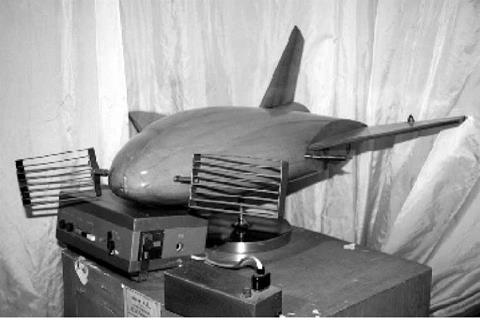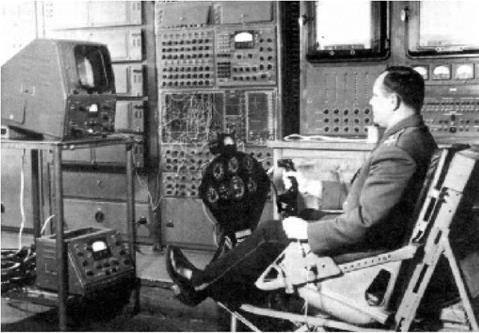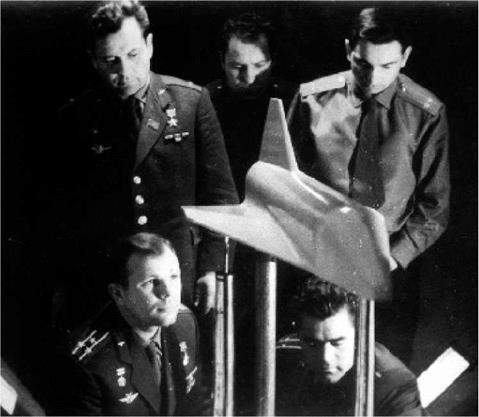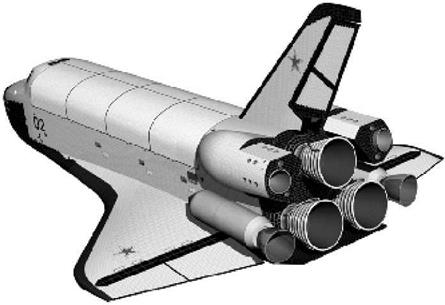Orbiter IK (Buran)
After returning from its mission on 15 November 1988, the 1K orbiter was sent back to the MIK OK orbiter-processing facility for post-flight inspections. Those were interrupted in early May 1989 for test flights with the An-225 Mriya carrier aircraft, staged from the Yubileynyy runway. This was in preparation for the long flight to the Paris Air Show the following month (see Chapter 4). In late June 1989 Mriya returned Buran back to Baykonur. The pair made one last demonstration flight over
|
Buran at the MIK OK in 1997 (B. Vis). |
Baykonur on 12 April 1991 as part of an air parade to mark the 30th anniversary of the flight of Yuriy Gagarin. Later that year Soviet space officials discussed the possibility of bringing Mriya and Buran to the International Aerospace Convention in Huntsville, Alabama in July 1992, but those plans were never realized [45].
As it turned out, the demonstration flight in April 1991 had been the last time that 1K ever took to the skies. In early 1990 Western reports claimed vehicle 1K had been retired from flight status. As it had been built without a life support system, full avionics systems, and a fuel cell electrical system, it was considered too costly and difficult to modify the vehicle for a future useful unmanned or manned flight [46]. Another reason given for the grounding of vehicle 1K was that design changes had been introduced in the newer airframes under construction at the Tushino Machine Building Factory that would be too expensive to incorporate into the older vehicle. Moreover, the Soviet policy apparently was that each airframe had a lifetime of 10 years, no matter how many flights it made. With construction of 1K having started in 1983, the ship was nearing the end of its warranty [47]. However, given the astronomical cost of building an orbiter, it is hard to imagine that the Russians would have strictly adhered to this policy. In fact, vehicle 1K still figured prominently in the Mir – 2 assembly plans outlined in late 1991. The reported retirement of the first flight vehicle may have had more to do with the increasingly bleak prospects for the program than anything else.
For years, Buran languished in the thermal protection system bay of the MIK OK, only to be shown to occasional visitors. In 1994 the idea arose to save it from oblivion by mating it with an Energiya rocket for permanent display at the MIK RN Energiya assembly building. Since it was considered that the stack should resemble the real thing as much as possible, the intention was to attach Buran to flightworthy Energiya hardware mothballed at the MIK RN—namely, the core stage of vehicle 2L and the strap-on boosters originally earmarked for vehicle 3L. However, in the mid – 1990s a decision was made to remove the RD-170 engines from the strap-on boosters for vehicles 3L to 6L and ship them back to Energomash to be modified for use on Zenit-3SL rockets being built under the Sea Launch program. Finally, Buran was moved to high bay 4 of the MIK RN in July 1998 and assembled the following month with a non-flight rated Energiya consisting of the core stage of vehicle 5S1 and the strap-ons of vehicle 4M-KS [48].
As if its fate wasn’t sad enough, Russia’s only flown shuttle was reduced to scrap when the roof covering the three high bays of the MIK RN collapsed on 12 May 2002. The accident claimed the lives of seven men conducting repairs on the leaky roof. It was blamed on a combination of factors that had made the roof 1.5 times heavier than specified. First, the roof insulation material used during the construction of the MIK back in the 1960s was heavier than it should have been. Second, the roof had absorbed several days’ worth of heavy rains, and, third, more than 10 tons of new roofing material had accumulated on the building in preparation for the repairs. The collapse destroyed not only orbiter 1K, but also the other Energiya hardware remain-
|
Remains of Buran after the roof collapse (source: www. buran. ru). |
ing in the MIK: three core stages and two Blok-Ya launch pad adapters in high bay 3, eight strap-on boosters in high bay 4, and another eight strap-ons in high bay 5 [49].
Orbiter 2K (“Buran-2”)
The second spaceworthy orbiter 2K (sometimes called “Buran-2”, airframe nr. 1.02) arrived at Baykonur atop a VM-T carrier aircraft on 23 March 1988. Because of the relatively limited lifting capability of the VM-T, vehicle 2K arrived at the cosmodrome underweight and in a relatively “raw” state, with a lot of work still remaining to be done before its first flight. The Mir/Soyuz docking mission planned for 2K was
|
2K orbiter (front) and OK-MT mock-up in storage inside the MZK (source: Sergey Kazak/ Novosti kosmonavtiki). |
much more challenging than the conservative two-orbit test flight of vehicle IK. Because of that the ship needed to be outfitted with systems that had not been on the original orbiter, such as a partially operational life support system, fuel cells, a fully operational payload bay door actuation system, a docking mechanism, and a remote manipulator arm. The vehicle was also equipped with a single ejection seat and several non-ejection seats.
On 16 May 1991 vehicle 2K, attached to the 4M core stage and strap-ons, was rolled out to Energiya-Buran pad 37 for two weeks of tests. The roll-out was witnessed by the crew of Soyuz TM-12 (Artsebarskiy, Krikalyov, Sharman), who were making final preparations for their mission. One obvious external sign that the ship wasn’t quite ready for flight yet was that many of its heat-resistant tiles were still missing. Among the work done at the pad were load tests of the fuel cells and orbiter evacuation exercises. On 30 May the stack trundled back to the MIK RN to be prepared for three days of tests at the Dynamic Test Stand (7 June-10 June 1991). After that it once again returned to the MIK RN, where vehicle 2K was detached from the core stage and returned to the MIK OK [50].
Speaking at the International Astronautical Federation Congress in Montreal in October 1991, Yuriy Semyonov told reporters that the Energiya rocket for the Buran – 2 mission had been placed on the launch pad in preparation for a 10-15 second static test firing of its main engines, and there is some evidence that Energiya 3L did undergo such a test that year [51].
By the time the Energiya-Buran program was canceled, the 2K orbiter was said to be 95-97 percent ready. The vehicle was later moved from the MIK OK to the defunct Assembly and Fueling Facility (MZK), where it still resides today.














